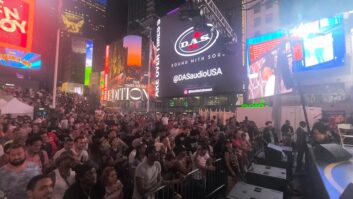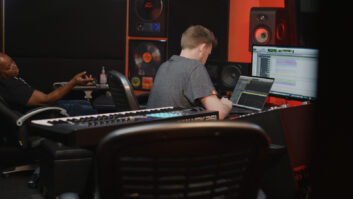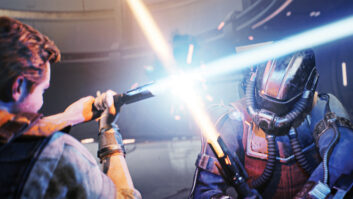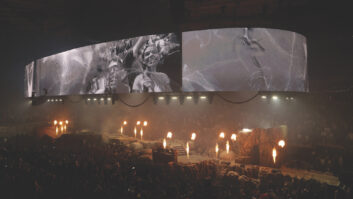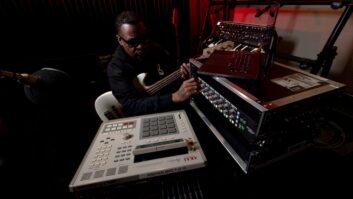You know there’s trouble brewing when one of your producers describes you with a string of adjectives: “The new album is kind of hip hop, soul, country…” starts John Gamble. “I don’t know exactly what to call it,” he concludes after a second of thought. “Erik has been a chameleon during his career, but what he’s doing now is not chameleon-like.”
“Erik” is Erik Schrody, better known as Everlast. The album he’s discussing is Eat at Whitey’s, the stunning follow-up to the brilliant smash hit Whitey Ford Sings the Blues. Everlast’s first musical forays were strictly hip hop, but nowadays he’s branched out into the realms of folk, blues, rock, and, yes, soul and country. Beck got away with it; Everlast probably will, too.
As a member of House of Pain, Everlast shot to the top of the charts on the strength of the party anthem “Jump Around.” It was an enviable position for anyone — except Everlast. The day before the band released their third album, the singer bolted. “We didn’t break up behind girls or money or anything like that,” Everlast explains. “I just found myself in a place where I couldn’t deal anymore, and I had to move on. I think with hindsight the guys understood it, and I think they might even respect me for it.”
Shortly after the demise of HOP, Everlast was preparing to record a solo hip hop album with Gamble and Dante Ross — the two are the Stimulated Dummies production team. While they were working on new songs, Everlast was staying at Ross’ house playing a borrowed guitar. Ross walked by one day and heard him playing “What It’s Like” on the six-string. A new career was about to be launched. “We didn’t even know he played guitar,” Gamble remembers. “We said, ‘Let’s just try. We’ll put some drum programming underneath it and cut a live guitar and bass and vocal thing over it.’ Once the demo of ‘What It’s Like’ was done, we knew we had something really strong and just kind of on an impulse changed directions.”
Whitey Ford Sings the Blues introduced all concerned to a brand new Everlast. Recorded at his Los Angeles home with a basic list of technical accoutrements, the album was a bit of a challenge. “Our studio [SD Studios in New York City] had been wired by somebody and had a patchbay,” Gamble says. “He didn’t even have that, so when we went out to do his record there, he didn’t have any mic pre’s or any stuff like that. It was very bare-bones. We were kind of inventing it as we were going along.”
In between Whitey Ford Sings the Blues and Eat at Whitey’s, Everlast toured the world, won a Grammy, thanks to his work with Carlos Santana on Supernatural (“Put Your Lights On”), and became more comfortable as a songwriter. In fact, when it came time to work on the follow-up, it was almost an old story that Everlast could actually sing and play the guitar. “Well, I hope it’s not that old of a story,” he says with a laugh. “I’m still exploring all that; it’s fun. We just figured that out on the last record. On this record, the goal for me personally was to find out if that was luck or if I could write songs. I’m not even talking about on a success scale like selling records. I was strictly trying to find out if I could write songs.”
For Eat at Whitey’s, the production team brought the party to New York and welcomed touring keyboard player Keith “Keefus” Ciancia into the studio. “There was an additional great musician, set of ears and creative person who had a very large arsenal of old synths and Clavs and a ton of stuff,” Gamble points out. “It seemed natural to go even more in the direction that we had in the first record. I feel the record is more musical.”
Indeed. Thanks to songs like “Love for Real,” which blends bits of hip hop and soul, and the sultry vocal additions of N’Dea Davenport, this album is brimming with musicality. Producer Dante Ross calls “Love for Real” one of his favorite songs on the album, perhaps because it challenged him. “I thought that it was a good tune, but initially it was more of a singer/songwriter tune as opposed to a soul tune,” he explains. “I heard it as a soul tune, and I was like, ‘Yo, we can do it like some Superfly, Bill Withers-y, Al Green shit. We can break out some strings and make it real Stax-y and funky.’ So we just went for it.” In addition to the string arrangement — courtesy of David Campbell — Ross and Everlast came up with a horn arrangement and added it the same day as the string tracking.
Creative sparks flew when Davenport and Everlast sang together in the studio. “She’s a natural and so is Erik, so it’s not like rocket science. They are both pretty emotive and soulful, so you just go for performance and try to steer them along,” Ross says.
“Those are great situations,” Gamble adds. “It’s the reason that we are involved in this business, to be around great music. When you’re in a situation like that, you get a big smile on your face. It’s very difficult to plan that. More often than not, that comes out of the blue. You try and make everything happen.”
Producers Ross and Gamble do have the ultimate responsibility to make sure the studio vibe is right, especially when guest performers are appearing. Davenport, Merry Clayton, Cee-Lo and rappers B-Real, Rahzel and Kurupt joined Everlast this time around. For Ross it was easy to set the right mood. “With N’Dea, you want to enhance the sensuality in what she does a little more, so you want to set the mood a little differently,” he says. “It’s a little more gentle and cerebral. When you’re with some rap cats, it’s a little more amped and you get the energy up. With B-Real or cats like that, those guys are pros when it comes to rapping. So it’s not incredibly difficult. It’s good. I’m lucky like that, because when you work with professionals, it makes your job so much easier.” Reprising his role as Everlast collaborator on Eat at Whitey’s was Carlos Santana. This time, the guitar legend contributed his talents to the song “Babylon Feeling,” tracking his part at Fantasy Studios in Berkeley, Calif.
The Campbell string dates at Ocean Way in Los Angeles and the Santana tracking sessions were the only ones that took place outside of Ross’ basement studios. As Gamble explains it, the studio is built around a Mackie Digital 8-bus console and two 24-track sidecars. The room also features an Otari MTR-90 III, three ADAT XT20s and Logic Audio running on Mark of the Unicorn (one MOTU 2408 and two MOTU 1224s). “Everything locks up and anything can be the master or the slave the way I have it hooked up here,” Gamble notes.
Though he’s been happy with his setup, Gamble reports that the Stimulated Dummies studio will soon feature Pro Tools: “I’m sick of synching things up and things drifting and working in different environments and having to remember everything. I’ve done a couple of sessions with people who are using 5.0, and it sounds great to me. I used to have some sonic issues with the converters, but now with the 24-bit, 96kHz 888s, they sound really great.”
Gamble’s vocal microphone of choice is the Neumann U87 paired with an Avalon VT-737 preamp. SDS is also stocked with compressors like LA-2As, LA-3s, JoeMeek SC2.2, dbx 160A, as well as a pair of Danish broadcast compressors, NTP 179-120s.
Before they get to recording Everlast’s parts, Gamble and Ross are responsible for putting down much of the music tracks for the album. They program drums using Emagic’s Notator running on an Atari 1040ST. Other sequencers at SDS include Akai S1000, Akai S6000, Kurzweil K2500 and Casio SV-20. Ross explains, “I’m trying to accentuate the best parts of the song, make sure the arrangements are right, make sure the drums sound cohesive with the guitar and the vocal textures, make sure everything matches. With him, it’s pretty easy; it’s just accentuating what works and making it work a little more.”
Where Gamble used a bevy of adjectives to describe Everlast, Ross has but one: “Intense,” he says. “We worked pretty fast this time. He had pretty good songs. It’s nice to work on records when you don’t have to hold people’s hands and do everything. On this one, he had more of a vision, he was more self-empowered. I thought his vision was correct, so I just helped to enhance it. It’s like he has a painting in his head, and I just try to get it on canvas.”

